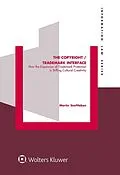The Copyright/Trademark Interface
How the Expansion of Trademark Protection Is Stifling Cultural Creativity
Martin Senftleben
The registration of cultural icons as trademarks has become a standard protection strategy in the field of contemporary cultural productions and plays an ever-increasing role in the area of cultural heritage. Attempts to register and 'evergreen' the protection of cultural signs, ranging from 'Mickey Mouse' to the 'Mona Lisa', are no longer unusual. This phenomenon - characterized by the EFTA Court as trademark registrations motivated by 'commercial greed' - has become typical of an era where trademark law is employed strategically to withhold or remove cultural symbols from the public domain. In an extraordinary analysis of the clash between culture and commerce, and imbalances caused by protection overlaps arising from cumulative copyright and trademark protection, this book draws attention to the corrosive effect of indefinitely renewable trademark rights and underscores the necessity to safeguard central preconditions for the proper functioning of the copyright system in society at large: the freedom to use pre-existing works as reference points for the artistic discourse and building blocks for new creations, and the need to ensure the constant enrichment of the public domain.
Emphasizing how overlapping copyright and trademark protection endangers the proper functioning of intellectual property rights in the literary and artistic domain, the author examines whether the intellectual property system is capable of mitigating the risks arising from cumulative protection. Such issues and topics as the following are treated in depth:
- the different configuration of intellectual property rights in accordance with different policy objectives and societal functions, in particular the cultural imperative in copyright law and the market transparency imperative in trademark law;
- problems arising from the registration of cultural icons for use on souvenir and merchandising articles;
- lack of sufficient safeguards in trademark law against cultural heritage branding;
- current scope of trademark rights, including the protection of brand value and communication functions, and the deterrent effect of trademark protection on cultural creativity;
- possibility of a categorical exclusion of contemporary cultural icons and cultural heritage material from trademark protection;
- development of a strict gatekeeper requirement of 'use as a mark' to prevent unjustified trademark infringement claims;
- development of robust, culturally based defences against trademark infringement claims; and
- general guidelines for the regulation of protection overlaps in intellectual property law, based on insights derived from the analysis of copyright/trademark overlaps.
Drawing on aesthetic, sociological and economic theories that support initiatives to safeguard the autonomy of the literary and artistic domain and support remix activities of artists, the author suggests sound criteria for identifying signs with cultural significance that should be excluded from trademark registration. The book shows how intellectual property law can make rights cumulation strategies less attractive and avoid the loss of inner consistency and social legitimacy, easing the tension between indefinitely renewable trademark rights and the need to preserve and cultivate the public domain of cultural expressions and other intellectual creations that enjoy protection for a limited period of time, such as industrial designs and technical know-how. Its assessment criteria will assist and enable trademark examiners and judges to identify relevant cultural signs, and its proposals for regulatory responses to protection overlaps in intellectual property law will prove of great and lasting value to lawyers, policymakers, and scholars dealing with intellectual property law.
Klappentext
Although ideally a patent system for pharmaceuticals should serve to incentivize research into the development of new medicines, the COVID-19 pandemic has exposed the equal importance of drug access and affordability. This book, by focusing on the Brazilian rule which makes the grant of pharmaceutical patents dependent on the prior consent of the National Health Surveillance Agency (ANVISA), shows how the Brazilian model affords an example for other countries to follow in dealing with tensions between patent protection and the right to healthcare. Based on an empirical study in which the author examined 147 reports issued by ANVISA as a basis for its decisions, the book deals with such central questions concerning the interface of regulation and innovation in the patent system as the following: compatibility between ANVISA's prior consent mechanism and the Trade-Related Aspects of Intellectual Property Rights (TRIPS) Agreement; how ';evergreening' and ';trivial patents' undermine public health and access to medicines; ways of correcting abuses of patent rights and controlling quality of patents; and the discourse on health as a human right. Along with her examination of ANVISA reports, the author analyzes how Article 229-C LPI, which introduced the need of ANVISA's prior consent to the patent grant of pharmaceuticals in Brazil, has been interpreted in Brazilian case law. Interviews with Brazilian experts are also included. In its commitment to harmonizing patent rights and the right to access of affordable medicines, Brazil's patent system for pharmaceuticals stands out as a workable response to the basic problem of access to medicines in the developing world. By describing the successes and failures in the Brazilian policy of promoting drug access, this book helps policymakers in developing and emerging countries to better explore TRIPS flexibilities when dealing with similar problems, and provides practitioners in the law of the World Trade Organization, patent law, competition law, and health law with a guide to how a more equitable pharmaceutical patenting system could work in practice.
